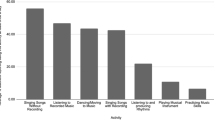Abstract
This study tried to identify the psychosocial dispositions and environment conducive to the development of a creative musician. A sample of 14 established musicians (vocalists and instrumentalists) belonging to Hindustani music tradition was selected from three major cities of Uttar Pradesh and were interviewed in-depth. They were interviewed about their early childhood, training in music and growing up as a musician. A thematic analysis yielded three major psychosocial themes pertaining to nurturance of creativity—developmental dispositions, preferred settings for music practice (Riāz) and performance, and relationship with Guru. Many participants showed proclivity to be creative musician, but all needed to have intrinsic motivation, nurturing social environment, and proper setting for riāz. They also reported that learning under a worthy guru was important for their creativity to blossom. Implications of these findings for training of the music students in an institutional set up were discussed.
Similar content being viewed by others
References
Braun, V., & Clarke, V. (2006). Using thematic analysis in psychology. Qualitative Research in Psychology, 3, 77–101.
Cropley, A. (1967). Creativity. London: Longman.
Csikszentmihalyi, M. (1996). Creativity, flow and the psychology of discovery and invention. New York: Harper-Collins.
Csikszentmihalyi, M. (1998). Finding flow: The psychology of engagement with everyday life. Basic Books.
Csikszentmihalyi, M. (1999). Implications of a systems perspective for the study of creativity. In R. J. Sternberg (Ed.), Handbook of creativity (pp. 313–335). NY: Cambridge University Press.
Deliège, I., & Richelle, M. (2006). The spectrum of musical creativity. In I. Deliège & G. A. Wiggins (Eds.), Musical creativity: Multidisciplinary research in theory and practice (pp. 1–6). Hove: Psychology Press.
Dewett, T. (2007). Linking intrinsic motivation, risk taking, and employee creativity in an R&D environment. R&D Management, 37, 197–208.
Kakar, S., & Kakar, K. (2007). The indians: Portrait of a people. New Delhi: Penguin.
Kemp, A. E., & Mills, J. (2002). Musical potential. In R. Parncutt & G. E. McPherson (Eds.), The science and psychology of music performance. New York: Oxford University Press.
Kippen, J. (1988). The Tabla of Lucknow: A cultural analysis of a musical tradition. Cambridge: Cambridge University Press.
Mansukhani, G. S. (1982). Indian classical music and sikh kirtan. London.
Moore, C. A. (Ed.). (1968). The status of the individual in east and west. Honolulu: University of Hawaii Press.
Neuman, D. M. (1980). The life of music in North India. Detroit: Wayne State University Press.
Oers, V. B. (1991). Talks to teachers on mathematics education. Internal paper. Department of Psychology and Education, Free University, Amsterdam.
Panda, M. (2011). Cultural construction of creativity: Dualism and beyond. In M. Cornelissen, G. Mishra, & S. Verma (Eds.), Foundations of Indian psychology. New Delhi: Pearson.
Perry-Smith, J. E. (2006). Social yet creative: the role of social relationships in facilitating individual creativity. Academy of Management Journal, 49, 85–101.
Raghavan, V. (1966). The great integrators: The saint-singers of India. New Delhi: Publications Division.
Ranade, A. (1984). On music and musician of Hindustan. New Delhi: Promilla & Co.
Rhodes, M. (1961). An analysis of creativity. Phi Delta Kappan, 42, 305–310.
Running, D. J. (2008). Creativity research in music education: a review (1980–2005). Update: Applications of Research in Music Education, 27(1), 41–48.
Siegell, M. M. (1988). Finding it as oneself: A psychological inquiry into the classical music tradition of the north India. Unpublished Doctoral Dissertation. Union Graduate School, Cincinnati, Ohio.
Silvia, P. (2008). Interest: the curious emotion. Current Directions in Psychological Science, 17, 57–60.
Simms, R. (1994). Some thoughts on the meaning of riaz in Hindustani music. Bansuri, 11, 6–14.
Simonton, D. K. (2000). Creativity: cognitive, personal, developmental, and social aspects. American Psychologist, 55(1), 151–158.
Sternberg, R. J., & Lubart, T. I. (1991). An investment theory of creativity and its development. Human Development, 34(1), 1–31.
Vellody, T. (2010). The mediamorphosis of Hindustani music: An examination of the role of emergent technologies in the transformation of Northern Indian music. Capston, Arts and Administration, University of Oregon, US.
Wade, B. (1979/1987/2001). Music in India: The classical traditions. Englewood Cliffs: Prentice-Hall.
Wade, B. C. (2009). Thinking musically: Experiencing culture. (2nd ed.). Oxford University Press.
Author information
Authors and Affiliations
Corresponding author
Rights and permissions
About this article
Cite this article
Upadhyay, D.K., Dalal, A.K. Growing Up as a Creative Musician: The Role of Psychosocial Dispositions and Environment. Psychol Stud 58, 427–436 (2013). https://doi.org/10.1007/s12646-013-0218-6
Received:
Accepted:
Published:
Issue Date:
DOI: https://doi.org/10.1007/s12646-013-0218-6




